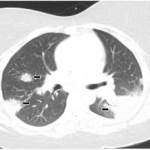WASHINGTON, D.C.—Speakers discussed some key characteristics, diagnostic challenges and treatment considerations for neurosarcoidosis at an ACR Convergence 2024 session, Neurosarcoidosis: Sharing the Headache, in which they emphasized the importance of collaborative care.
Neurosarcoidosis Features & Diagnostics
The multi-system inflammatory disorder sarcoidosis requires extensive diagnostic exclusion. It is a rare condition characterized by the formation of noncaseating granulomas in various organ systems. A minority of these patients have symptoms related to granulomas in the nervous system, termed neurosarcoidosis.
One of the speakers, Shruti Agnihotri, MD, director of the Division of Comprehensive Neurology at the University of Alabama at Birmingham, noted a 2017 study that found that 34% of sarcoidosis patients had neurological involvement, although previous estimates placed this lower.1 Neurologic manifestations are the presenting features in around 50% to 70% of neurosarcoidosis patients, so people with neurosarcoidosis don’t always carry a previous diagnosis of sarcoidosis. In patients with known sarcoidosis, about 5% eventually develop neurological involvement.2
The severity and specific clinical manifestations of neurosarcoidosis are highly variable. Cranial neuropathies are the most frequent presentation, most commonly involving the optic or facial nerve. Optic neuropathy tends to cause subacute vision loss, usually with retrobulbar pain.
Myelopathy is another common presentation, but neurosarcoidosis can also present as an aseptic meningitis or as parenchymal disease (e.g., of the pituitary gland). Peripheral nervous system symptoms can also occur, although less commonly than central nervous system disease, for example, a large fiber-type neuropathy with a mononeuritis multiplex presentation.
Dr. Agnihotri added that small fiber neuropathies seem to be quite common in sarcoidosis. Current consensus is that these should qualify as para-neurosarcoidosis, as they don’t seem to directly result from granulomatous infiltration nor respond well to standard sarcoidosis treatments.
Diagnosis of neurosarcoidosis is typically a challenging, multistep process often necessitating collaboration between multiple specialties, as symptoms overlap with those of many other neoplastic, autoimmune, infectious and cardiovascular diseases.
Achieving a diagnosis of definite neurosarcoidosis is relatively uncommon, as it requires specific clinical features, consistent diagnostics (e.g., magnetic resonance imaging, cerebrospinal fluid and/or electromyography/nerve conduction studies) and nervous system histology, and neural samples are difficult to obtain for the latter.2,3 More often, patients are diagnosed with probable neurosarcoidosis, in which clinical presentation and diagnostics are consistent with neurosarcoidosis, and histology confirms sarcoidosis in another system. These features without any histologic confirmation may be termed possible neurosarcoidosis.3



